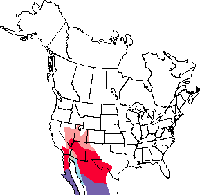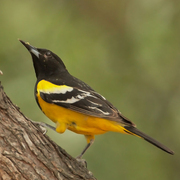Scott's Oriole
General Description
The adult male Scott’s Oriole cannot be confused with any other bird likely to be seen in Washington. A large oriole—the size of a Bullock’s—it has a black head, back, and breast; vivid yellow underparts; a black wing with a yellow shoulder patch and white wingbar; and a black tail with a yellow base. The adult female resembles the male but with less extensive black. However, immature birds can be easily misidentified, especially when they occur in unexpected places. Grayish above and dirty yellow below, they look rather like certain plumages of the somewhat smaller Hooded Oriole. In Washington, any oriole that appears to be outside the norms for Bullock’s Oriole should be studied attentively. Consultation of a good field guide is advised.
Scott’s Oriole is a bird of the deserts of the American Southwest and of northern and central Mexico. Breeding populations of the northern part of the range, including the United States, move south for the winter. Scott’s Oriole breeds locally in southeastern Idaho at the northern extremity of its breeding range. Otherwise it is an exceptionally rare vagrant in the Pacific Northwest. Oregon has two spring records. Washington’s lone record is of an adult male that frequented a feeder in Chehalis (Lewis County) from 11 February to 13 April 1980. There are no records from British Columbia.
Revised November 2007
North American Range Map


Family Members
 BobolinkDolichonyx oryzivorus
BobolinkDolichonyx oryzivorus Red-winged BlackbirdAgelaius phoeniceus
Red-winged BlackbirdAgelaius phoeniceus Tricolored BlackbirdAgelaius tricolor
Tricolored BlackbirdAgelaius tricolor Western MeadowlarkSturnella neglecta
Western MeadowlarkSturnella neglecta Yellow-headed BlackbirdXanthocephalus xanthocephalus
Yellow-headed BlackbirdXanthocephalus xanthocephalus Rusty BlackbirdEuphagus carolinus
Rusty BlackbirdEuphagus carolinus Brewer's BlackbirdEuphagus cyanocephalus
Brewer's BlackbirdEuphagus cyanocephalus Common GrackleQuiscalus quiscula
Common GrackleQuiscalus quiscula Great-tailed GrackleQuiscalus mexicanus
Great-tailed GrackleQuiscalus mexicanus Brown-headed CowbirdMolothrus ater
Brown-headed CowbirdMolothrus ater Orchard OrioleIcterus spurius
Orchard OrioleIcterus spurius Hooded OrioleIcterus cucullatus
Hooded OrioleIcterus cucullatus Bullock's OrioleIcterus bullockii
Bullock's OrioleIcterus bullockii Baltimore OrioleIcterus galbula
Baltimore OrioleIcterus galbula Scott's OrioleIcterus parisorum
Scott's OrioleIcterus parisorum

